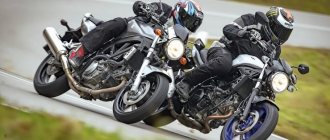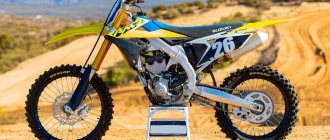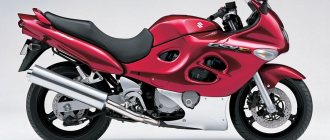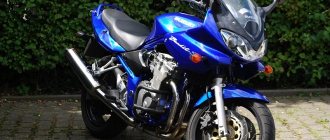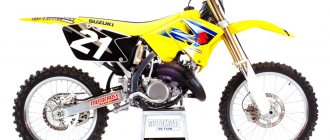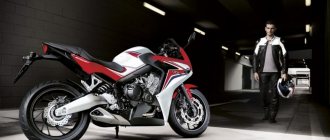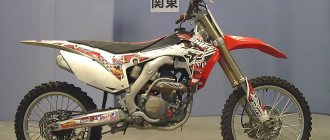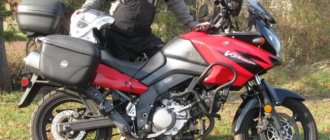Ten years is a long time. How have motorcycles changed in ten years? Today we have two popular cars as patients: the old model Suzuki SV 650 and the same, but new one.
Suzuki SV 650
I swing my leg over the seat of the Suzuki SV 650, which has not changed since 2007, take the steering wheel, start the engine and look at the clock. At that moment, I had the impression that the time machine had taken me back a good few years.
The recipe for the Suzuki SV, first revealed in 1999, was as simple as it was ingenious: a strong twin-cylinder engine accompanied by a timeless yet interesting design, without the bike's price being a drain on the wallet. This is how a very good universal naked bike was made. However, it had its drawbacks. For example, the Suzuki SV models of the first years of production had the same suspensions.
Suzuki engineers have spent years perfecting the SV 650 thanks to our riders, their pressure and changing regulations. In the first version, power supply was the task of classic carburetors. New regulations introduced in 2003 meant that the car received fuel injection, two flaps in each of the intake manifolds and a catalytic converter. The Suzuki St. 650 engine has lost a little of its sharp character, but its operating culture has improved significantly.
suzuki 650 motorcycle
Another change to the Suzuki SV 650 on the way to perfection
The 2007 season brought further improvements: the brake system received ABS, the engine received two spark plugs per cylinder, and the cylinder heads themselves changed. For this reason, it was necessary to redo almost all elements of the ignition system, injection system, air filter housing and muffler.
Thanks to all this and adjustable catalysts, the requirements set by the Euro 3 standard were met. Reactions to gas additions and load changes became smoother. The maximum power of the sv650s was 72 hp.
The two-piston terminals are identical. And rightly so - why change something that works properly? The ABS switch has been modified to accommodate this. Of course, modern ABS works more accurately. In the new model, its sensor is installed on the left side of the wheel.
suzuki 650 motorcycle
The analog tachometer is clearer, but the 2021 model's LCD display provides more information.
Technical changes to the Suzuki sv650s engine are an evolution, not a revolution. New regulations forced the introduction of fuel injection and catalysts.
In terms of appearance, the 2007 version of the Suzuki SV 650 was dominated by sharper lines. The fuel tank was wide and the rear end looks rather oversized compared to the last model. Although the new bike, 10 years younger and seemingly less bulky, weighs exactly the same as its predecessor, or 199 kg to be exact.
suzuki st
The dashboard of the old Suzuki SV 650 “smells like a dead mouse”, but in my opinion, the analog tachometer is much clearer than the digital one. There's also one small thing I appreciate about the old SV: I really enjoy watching the tachometer move up the dial after each gear shift. It has its own charm.
If you have Scots among your ancestors, you will probably appreciate that fuel consumption has decreased by 0.5 l/100 km over 10 years. This is all the more interesting because both motorcycles have almost the same engine. The ratio of cylinder diameter to piston stroke also did not change, but the compression ratio was slightly reduced.
The changes that have been given to the engine are invisible. Well, aluminum cylinders don't have classic liners. Their insides were coated with a thin layer of wear-resistant oxides. The new pistons are installed better, that is, less loose, moreover, the piston rings have been replaced, the crankshaft has been increased by 10%, and the exhaust valves have a larger diameter.
Result? The new V-twin is stronger than its predecessor and also delivers power smoother, more dynamically and with less vibration.
Suzuki SV 650
In this model, the frame is made of aluminum profiles, and its rear strut is tightened. The split sofa is a distinctive feature of the old SV650. Steel monocoque frame, narrower fuel tank and softer, cooler rear view. The round spotlight is the same as in the 2007 version.
001_MOTO_0210–038
Suzuki SV650.
Suzuki SV650.
PONY IS ALSO HORSES. In contrast to the global trend of “faster-higher-stronger”, the Japanese Big Four do not hesitate to release humpbacked skates. Inconspicuous in appearance, with an antediluvian suspension design, slightly modernized engines from the “heroes of yesteryear”, not distinguished by sky-high power figures, they appear, time after time, winning the hearts and wallets of thousands of motorcyclists. It seems like a paradox? But no. Everything is not logical in a fairytale way. Firstly, the “people's” motorcycle is a priori a classic. Have you ever seen a budget sportbike? Well, so that it has suspensions without adjustments or even a power system from the “last generation”? Terrible bad manners! Or a cruiser, where instead of chrome there is paint and a “one hundred and twentieth” cylinder at the back? Well, to make it cheaper. That’s just it, that the “polar” classes of motorcycles are always at the forefront - no matter what - technology, fashion, show-off... And the classic, especially the mid-sized one, is such a thing: modesty is its middle name. Not all riders (if not the majority), first of all, need not a “ponto-launcher”, but a device for everyday, comfortable movement of themselves in space, especially if we are talking not about Russia, but about the rest of the world. That’s why they live among the literally and figuratively shining flagships, inconspicuous at first glance animals: Honda’s CBF, Yamaha’s XJ... Our today’s hero, the Suzuki SV650, is from the same breed.
BURNED CITY RESIDENT. From the same breed, but not quite. The external and technological similarity with the Ducati Monster speaks for itself: the motorcycle was created as its own, Japanese alternative to the “Italian”. Apparently, the niche occupied by “monsters” in those years looked so attractive that Suzuki was not afraid to create a device that was destined to enter into an unequal battle for the consumer with a very strong rival. The paradox is here: Suzuki took the risk of launching a very “budget” motorcycle against a premium product, albeit the cheapest in the line. And they succeeded!
The design of the SV, although original, is quite prosaic. Aluminum frame a la “birdcage” (budget - budget, but the Japanese did not allow themselves to fence an “iron” garden), non-adjustable front fork with a minimum permissible by the standards of the era and class stanchion diameter of 41 mm and the simplest rear suspension with progressive characteristics and adjusting the spring preload. Further, everything is also without frills: a V-shaped engine with a cylinder camber of 90º, four-valve, twin-shaft heads and the usual chain drive of the shafts, two carburetors and a two-in-one exhaust.
This whole cocktail of “ordinariness” produces, without a couple of tenths, 70 hp. at 9000 rpm and 61.7 Nm at 7400 rpm. But what do we need dry numbers? After all, the main thing is how the motorcycle provides its forces and Newton meters for use. The opinion of the vast majority of owners and testers completely coincides: the motorcycle has an “ideal-city” characteristic of power and torque: the motor pulls perfectly from the very bottom, and gradually “gives up” to the top, but there are no dips or pick-ups, and some inertia (like and any “veshka”) forgives many mistakes in working with gas. The “correct” character of the engine is complemented by a low weight (dry - only 165 kg), a relatively low saddle (805 mm) and excellent (of course, by city standards) handling. In short, an almost ideal city motorcycle for a pilot of almost any height, build and driving experience. But, with one caveat: when used in the urban cycle. Any attempts to release “Sivka” into an open field, that is, on a country highway, instantly kill all its advantages. Frankly weak suspension, especially an overly soft fork, a screw-folding pendulum and a complete lack of wind protection make it almost impossible not only to turn with the knees, but also to move in a straight line at speeds above 160.
Of course, the “S” modification, “clad” in a semi-fairing, is better suited for traveling outside the “population”, but, unfortunately, the wind deflector is in no way capable of affecting the quality of the suspension. So, go to the track only in pensioner style: leisurely and surveying the surrounding landscapes.
BURKA-SECOND. Four years after its debut (pretty soon by the standards of budget classics), the SV is undergoing a major modernization. The motorcycle received a completely new frame made by vacuum casting (stiffness increased by 5%), a new fork with adjustable spring preload (though the same “orphan” diameter - 41 mm) and a modernized rear suspension, with increased travel and seven-position spring preload adjustment .
The engine acquired an injection system, and, due to the increased performance of the power system, an airbox and a muffler of increased volumes. This made it possible to slightly raise the power and torque curves throughout the entire rev range, and make the top end less sluggish. The oil system has its own radiator. Of course, the updated motorcycle also received a redesigned design - more “angular” shapes, coupled with an electronic “tidy” made its appearance more aggressive and modern.
ABS is much better
The quiet nature of the Suzuki SV engine goes well with the purpose of the motorcycle. The fact that the bike corners better and is stable in deep builds means it's useful for beginners. Uneven asphalt does not make his behavior nervous.
The fork and center shock performance on this machine is much better than the more comfortable but loosely tightened hinges of 10 years ago.
What about the brakes? The efficiency of the two-piston calipers is nothing to complain about, provided you don't go crazy. But we're not talking about this motorcycle! The biggest criticism of modern motorcycles is that they lack aggressiveness and crisp action.
Huge progress can be seen in the performance characteristics of ABS. Apart from a slight deceleration during braking, the Suzuki stays on course precisely. In the old SV650, where the front discs break the same clamps, the initial braking phase is quite sharp - but when the ABS comes in, the game is over.
The pressure in the brake system drops, the fork relaxes slightly - and at this moment ABS reminds us of its existence. The low frequency operation that was standard many years ago is unacceptable today. The most important thing to me is that the 2007 is stable and predictable under emergency braking.
Suzuki SV 650
002_MOTO_0210–039
The second generation SV received an oil cooler;
this helped reduce the thermal load on the lubrication system. The second generation SV received an oil cooler; this helped reduce the thermal load on the lubrication system.
There are still two versions in the line: N - a classic naked with a round headlight and S - in a semi-fairing, with two slanting “eyes”. True, this is not the only difference. The “sport” version has a slightly lower handlebar, the footpegs are moved up and back, and the rear suspension swingarm is 6 mm shorter. By the way, the saddle height of both modifications decreased by 5 mm and amounted to 800 mm. All this creates a slightly more collected, sporty landing, but, unfortunately, this cannot correct the outright weakness of the suspension. Yes, yes, such a serious modernization of the model, surprisingly, practically did not affect the main shortcomings. Although, I will not stop repeating again and again - if you do not demand from a motorcycle (and any equipment) beyond its programmed capabilities, it is unlikely to disappoint.
2021 Suzuki SV650 Specifications
- Engine: four-stroke, two-cylinder, double overhead camshafts, cylinders at an angle of 90 degrees, 645 cc, liquid cooling
- Bore and stroke: 81.0 mm × 62.6 mm
- Compression ratio: 11.2:1
- Fuel system: injection
- Starter: electric
- Lubrication: wet sump
- Chassis
- Transmission: six-speed, constant mesh
- Main drive: chain
- Chassis
- Front suspension: telescopic, coil-over, oil damping
- Rear Suspension: Linked, coil-over, oil damping, 7-position preload adjustable
- Front brakes: two two-piston calipers, 290 mm discs
- Rear Brake: Single-piston disc, 240mm disc
- Front tire: 120/70ZR17M/C, tubeless
- Rear tire: 160/60ZR17M/C, tubeless
- Fuel tank capacity: 14.4 liters/13.6 liters (CA model)
- Color: red-white
- Dimensions
- Length:2140 mm
- Width: 760 mm
- Curb weight: 195 kg/197 kg (model with ABS)
- Wheelbase: 1445 mm
- Ground clearance: 135 mm
- Seat height: 785 mm
- Warranty: 12 months, unlimited mileage
Brief history of the model
1999 - start of production and sales of Suzuki SV650 and Suzuki SV650S. First generation. Model: Suzuki SV650; Suzuki SV650S (Europe, North America, Australia). Factory designation: SV650X, SV650US; SV650SX, SV650SUX.
2000 - no significant changes. Model: Suzuki SV650; Suzuki SV650S (Europe, North America, Australia). Factory designation: SV650Y, SV650UY; SV650SY, SV650SUY.
2001 - no significant changes. Model: Suzuki SV650; Suzuki SV650S (Europe, North America, Australia). Factory designation: SV650K1, SV650UK1; SV650SK1, SV650SUK1.
2002 - no significant changes. Model: Suzuki SV650; Suzuki SV650S (Europe, North America, Australia). Factory designation: SV650K2, SV650UK2; SV650SK2, SV650SUK2.
2003 - restyling of the model. Second generation. Suzuki SV650 and SV650S models receive updated exterior styling, a new instrument panel, cast aluminum frame (instead of tubular), fuel injector, 17L fuel tank (instead of 16L), retuned suspensions and front fork preload adjustment. Model: Suzuki SV650; Suzuki SV650S (Europe, North America, Australia). Factory designation: SV650K3, SV650UK3; SV650SK3, SV650SUK3.
2004 - The model receives a new subframe and a narrower front seat. The rear fender gets a more advanced design and better protects the rear of the motorcycle from dirt. Model: Suzuki SV650; Suzuki SV650S (Europe, North America, Australia). Factory designation: SV650K4, SV650UK4; SV650SK4, SV650SUK4.
2005 - Starting this year, models feature a matte black frame and a smaller radiator. Model: Suzuki SV650; Suzuki SV650S (Europe, North America, Australia). Factory designation: SV650K5, SV650UK5; SV650SK5, SV650SUK5.
2006 - no significant changes. Model: Suzuki SV650; Suzuki SV650S (Europe, North America, Australia). Factory designation: SV650K6, SV650UK6; SV650SK6, SV650SUK6.
2007 - modifications with ABS appear, all models are equipped with 2 spark plugs per cylinder. Model: Suzuki SV650 + ABS; Suzuki SV650S + ABS (Europe, North America, Australia). Factory designation: SV650K7, SV650AK7, SV650UK7, SV650UAK7; SV650SK7, SV650SAK7, SV650SUK7, SV650SUAK7.
2008 - appearance of a modification with a full plastic body kit - Suzuki SV650SF (Sport). Model: Suzuki SV650 + ABS; Suzuki SV650S + ABS; Suzuki SV650SF (Sport) (Europe, North America, Australia). Factory designation: SV650K8, SV650AK8, SV650UK8, SV650UAK8; SV650SK8, SV650SAK8, SV650SUK8, SV650SUAK8; SV650SFK8.
2009 is the last year of production of the Suzuki SV650SF (Sport) modification. The regular SV650 in the US is being replaced by a new model, the Suzuki SFV650 Gladius. Model: Suzuki SV650 + ABS; Suzuki SV650S + ABS; Suzuki SV650SF (Sport) (Europe, North America, Australia). Factory designation: SV650K9, SV650AK9, SV650UK9, SV650UAK9; SV650SK9, SV650SAK9, SV650SUK9, SV650SUAK9; SV650SFK9.
2010 - only the SV650S version is available on the market. Model: Suzuki SV650S + ABS (Europe, North America, Australia). Factory designation: SV650SL0, SV650SAL0, SV650SUL0, SV650SUAL0.
2011 - no significant changes. Model: Suzuki SV650S + ABS (Europe, North America, Australia). Factory designation: SV650SL1, SV650SAL1, SV650SUL1, SV650SUAL1.
2012 - the SV650 model is finally discontinued. Model: Suzuki SV650S + ABS (Europe, North America, Australia). Factory designation: SV650SL2, SV650SAL2, SV650SUL2, SV650SUAL2.
2016 - “reincarnation” of the SV650 model. Suzuki offers a completely updated classic version of the Suzuki SV650 (2016+).
